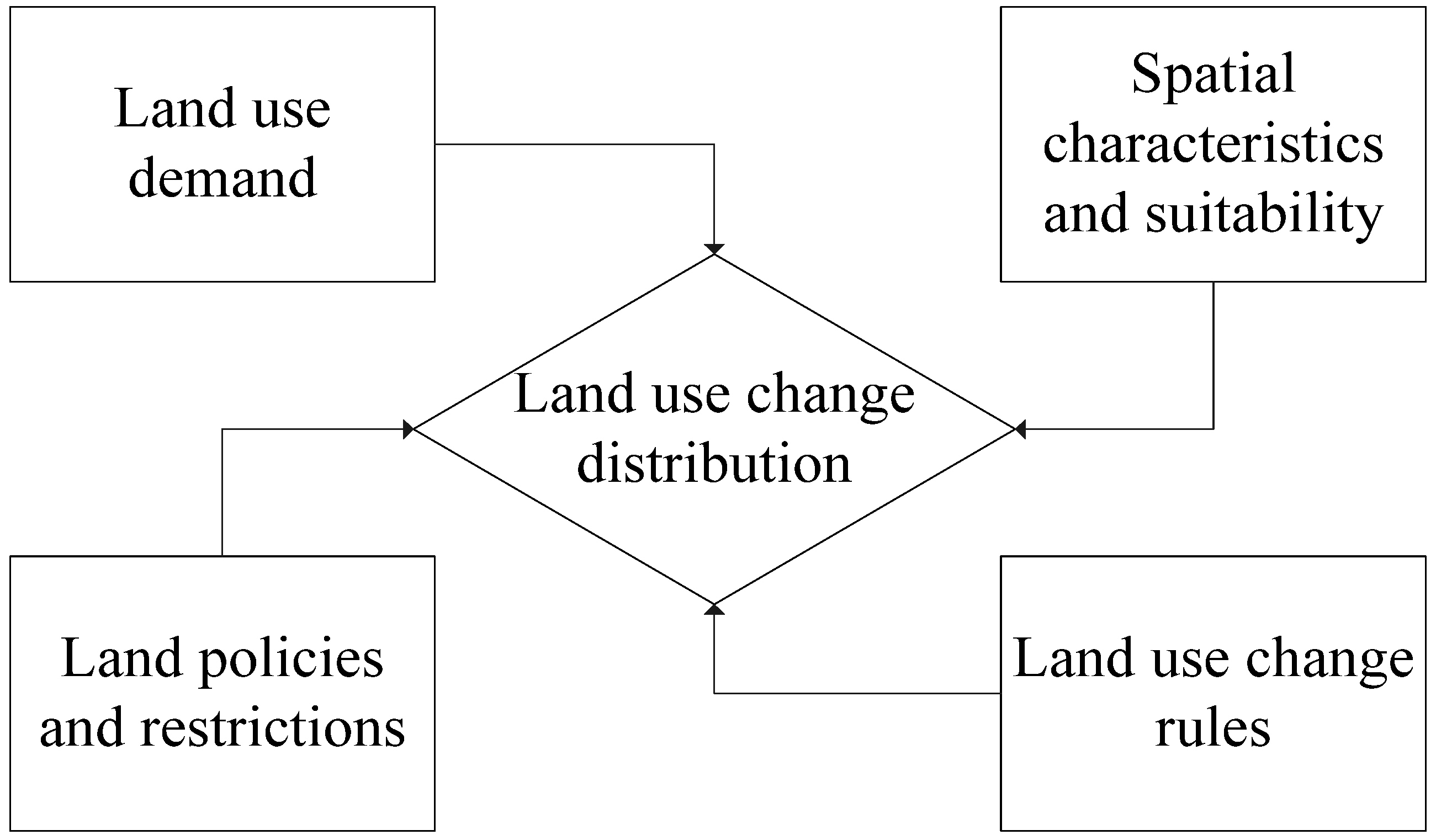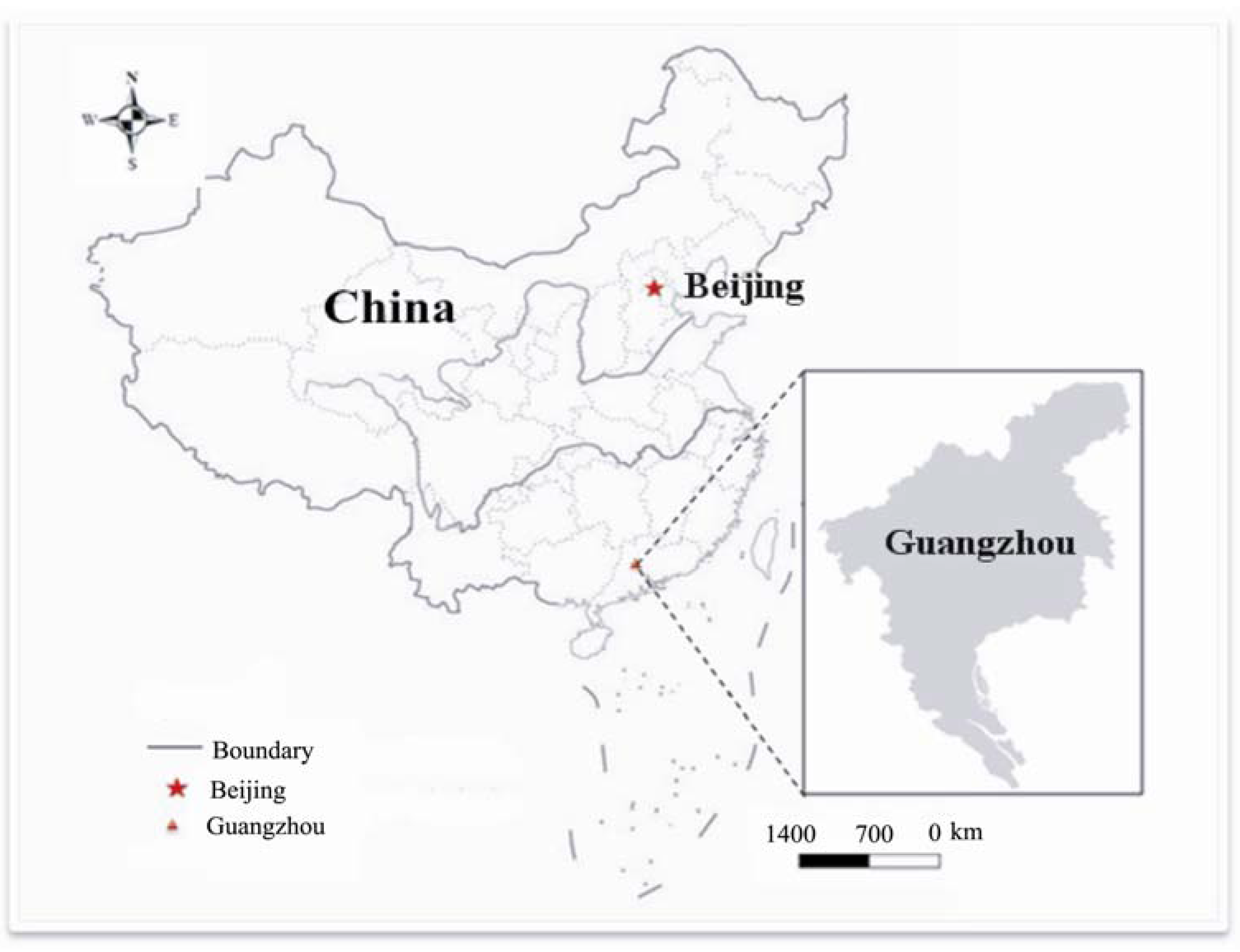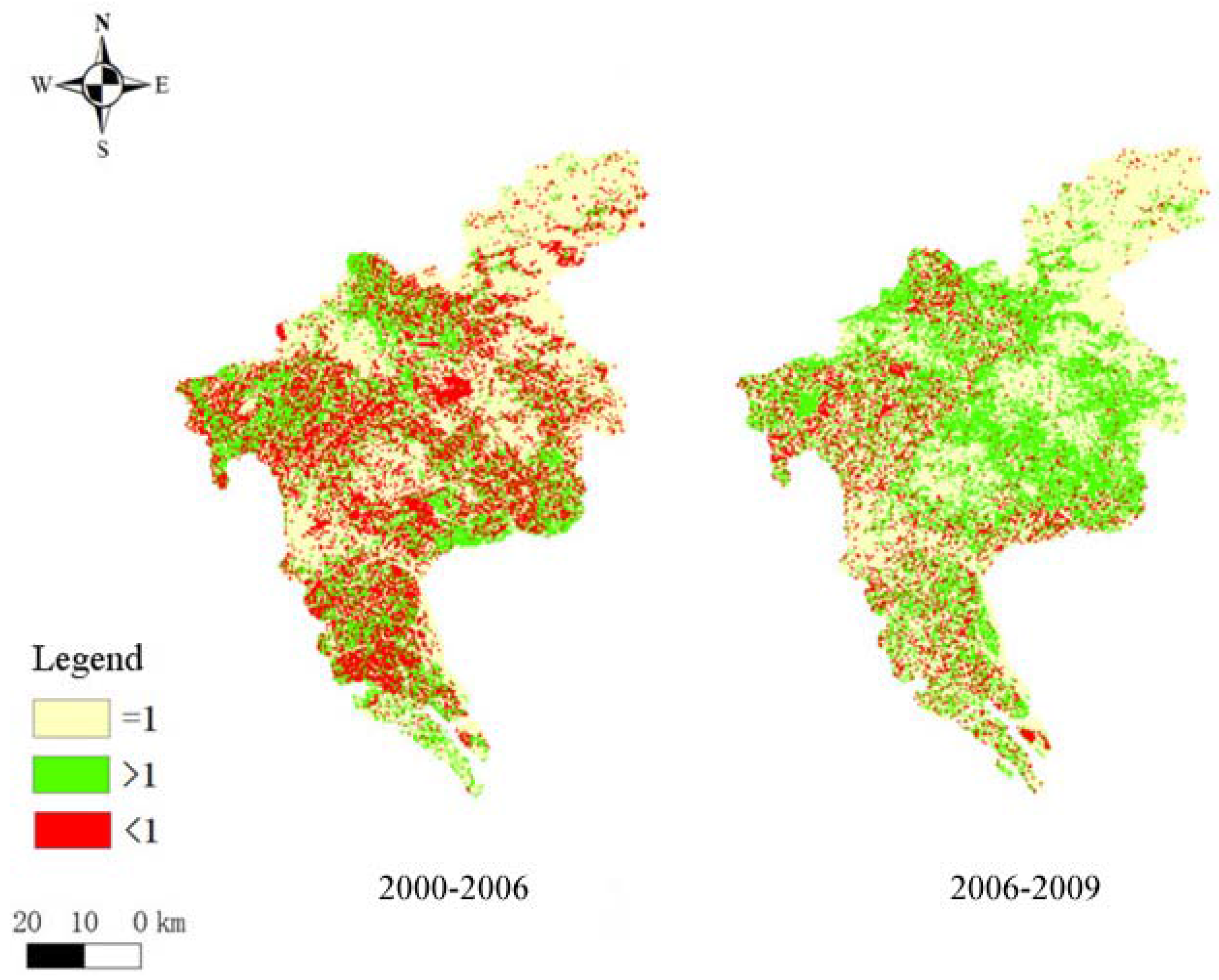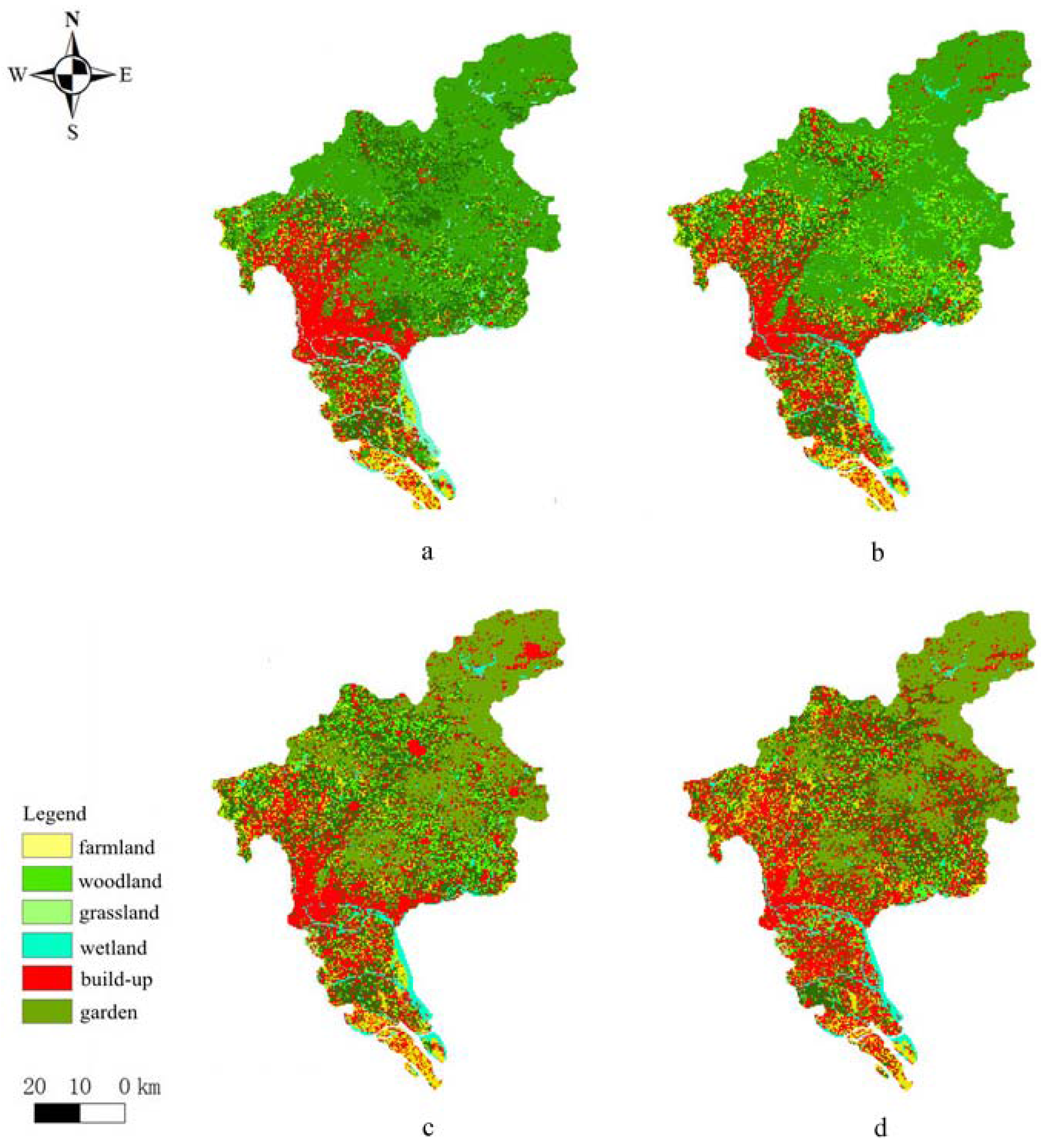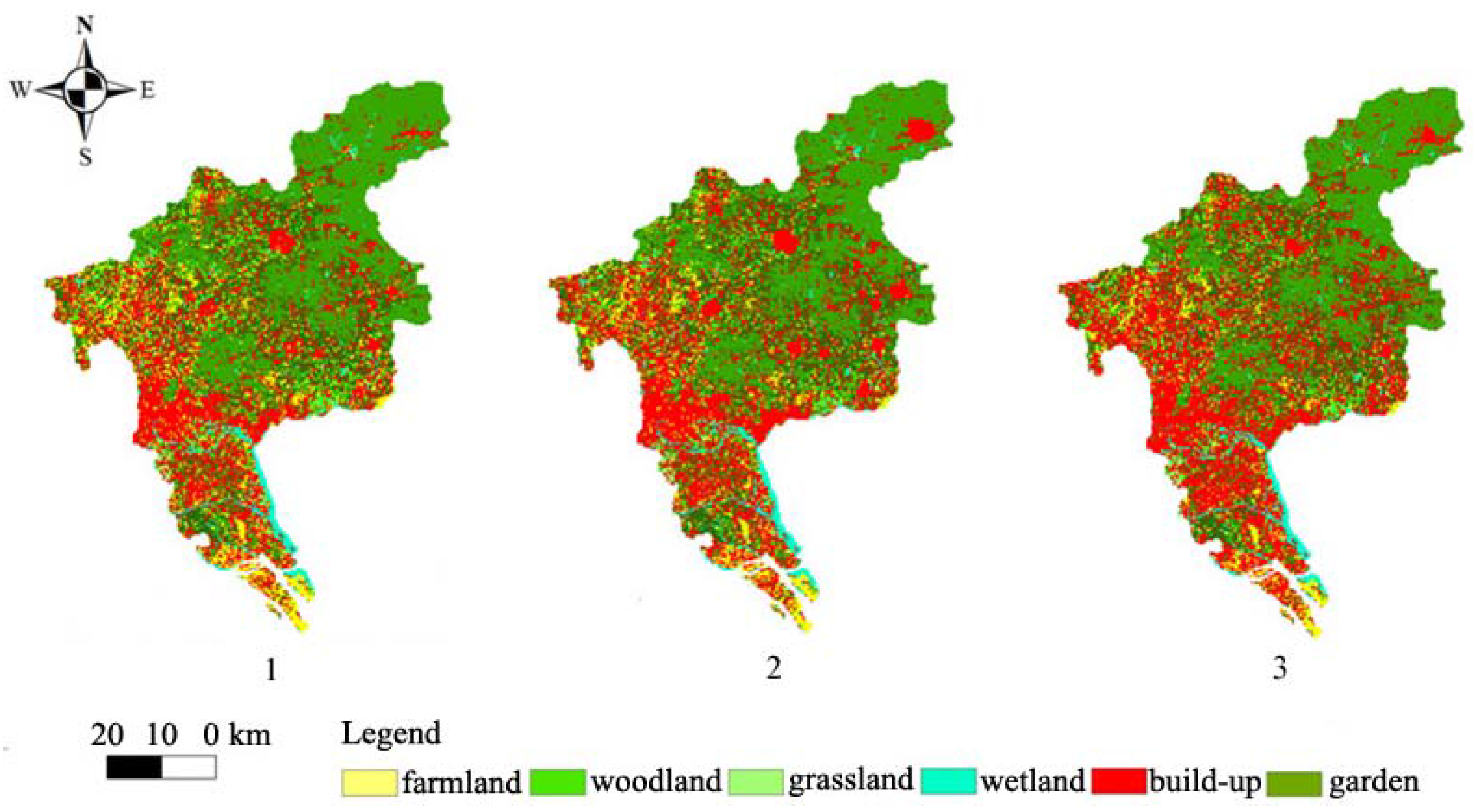Guangzhou city is the capital of Guangdong Province and is one of the most important industrial centers in China (
Figure 2). Guangzhou covers an area of 7434 km
2 and has a population of over six million. Guangzhou stands at the confluence of the East River, West River and North River, with the terrain sloping from NE to SW, and includes an alluvial plain in the southern and south-western regions. Guangzhou has a southern subtropical marine climate, with an annual average temperature of 21.8 °C, rainfall 1694 mm, and 345 frost-free days per year.
Figure 2.
Map of China showing location of Guangzhou.
3.1. Land-Use Data Collection, Standardization and Logistic Regression Analysis
3.1.1. Data Collection and Standardization
The data for the land ecological service supply index was standardized using the improved efficacy coefficient method [
25] to ensure that comparable requirements are met in different years. This is given by:
where
aij is the score for unit
i and element
j (the efficacy coefficient);
Xij is the actual value for unit
i and element
j;
Xjmax,
Xjmin are the upper and lower limits of element
j;
i = 1, 2 ...;
j = 1, 2 ...
The CLUE-S computation process is in two parts: first, the logistic method of land-use change-driven analysis is used to gauge the selected driving factors and calculate their relationship with each land-use category; second, the land transition rules to be used by the Dyna-CLUE program are defined; the program calculates the probability of each grid unit, i, being assigned a particular land-use category m, as described above. After comparing a number of units, the land category most likely to be converted to the target category is selected for the planning year, and the spatial simulation process is then completed using a standard iteration routine.
Land ecological supply is closely related to the service functions that the land provides. The main functions of land ecosystems were described above as the
raising,
bearing,
warehousing and
landscape functions [
22]. When the land ecosystem is capable of providing acceptable service functions, the entropy and the disorder of the ecosystem decreases. The land-use plan indicators defined for Guangzhou are listed in
Table 1.
3.1.2. Analysis of Land-Use Change Drivers Based on Logistic Methods
The spatial land-use data for Guangzhou in 2000, 2006 and 2009 was taken from land-use maps, electronic maps of rivers and lakes, traffic routes, settlements and other information in 2000. The source of the digital elevation model (DEM) data was from World Geodetic System (WGS) with 3 arc-second (approximately 90 m) resolution.
For the present study it was necessary to consider whether the data could be obtained, whether the factors could be quantified, and whether the data would correlate reasonably well with land-use change in the case study district, when equal attention was given to both natural and socioeconomic factors. On this basis, seven factors driving land-use change were selected: see
Table 2.
The data was extracted from remote-sensing images based on the six land-use categories shown on land-use maps of Guangzhou, then analyzed by the logistic method.
The relative operating characteristics (ROC) validation method [
26] was used to test the logistic regression results from the CLUE-S model. ROC values lie between 0 and 1: a ROC of 0.5 indicates that the predictions are completely random; values > 0.5 indicate that a prediction by the model is relatively good.
Table 1.
Land-use plan indicator set for Guangzhou, based on land ecological services supply index.
Table 1.
Land-use plan indicator set for Guangzhou, based on land ecological services supply index.
| Land ecological services supply index | Element | Original data (year) | Standardized data (year) |
|---|
| | 2000 | 2006 | 2009 | 2000 | 2006 | 2009 |
|---|
| Bearing | Road area per capita (m2/person) | 5.67 | 13.49 | 10.63 | 0.56 | 1.00 | 0.84 |
| Residential area per capita (m2/person) | 13.13 | 18.87 | 21.01 | 0.61 | 0.89 | 1.00 |
| Raising | Grain (kg/year/person) | 106.71 | 77.98 | 64.61 | 0.74 | 0.95 | 0.64 |
| Vegetables and their products (kg/year/person) | 112.92 | 104.56 | 56.49 | 0.91 | 1.00 | 0.93 |
| Oil and fat (kg/year/person) | 6.87 | 6.7 | 4.59 | 0.68 | 0.84 | 0.82 |
| Meat (kg/year/person) | 47.41 | 46.37 | 20.30 | 0.77 | 0.90 | 0.88 |
| Eggs (kg/year/person) | 8.62 | 6.24 | 4.31 | 0.86 | 1.00 | 0.72 |
| Warehousing | Coal (tonnes/year/10,000 yuan GDP) | 0.78 | 0.65 | 0.35 | 1.00 | 0.97 | 0.83 |
| Landscape | Rate of urban green coverage (%) | 31.6 | 36.38 | 38.21 | 0.72 | 0.86 | 0.91 |
| Green space area in parks (m2/person) | 7.87 | 11.32 | 13.76 | 0.50 | 0.78 | 0.97 |
| Proportion of woodland area (%) | 0.39 | 0.37 | 0.34 | 1.00 | 0.94 | 0.84 |
| Proportion of wetland area (%) | 0.12 | 0.14 | 0.18 | 0.63 | 0.75 | 1.00 |
Table 2.
Factors driving land-use change in Guangzhou.
Table 2.
Factors driving land-use change in Guangzhou.
| Factor classification | Driving factor | Factor description | Code |
|---|
| Distance | Distance to rivers, lakes and seas | The distance of each evaluation unit center to the nearest rivers, lakes and seas | X0 |
| Distance to national highway or urban road | The distance of each evaluation unit center to the nearest national highway or urban road | X1 |
| Distance to urban settlements | The distance of each evaluation unit center to the distance to the nearest town settlements | X2 |
| DEM | Slope | | X3 |
| Elevation | | X4 |
| Population density | Population | | X5 |
| Per-capita GDP | | X6 |
A logistic regression was run for each current land-use category (
Table 3). Appropriate driving factors selected from those listed in
Table 2 were used to evaluate the suitability of a given unit to be developed into a particular land-use category. The spatial distribution of all categories of land use was explained well by the selected driving factors, as indicated by the ROC value ≥ 0.7 in all cases.
Table 3.
Values of β from logistic regression of spatial distribution of land use in Guangzhou.
Table 3.
Values of β from logistic regression of spatial distribution of land use in Guangzhou.
| Land use category | Population density | Per capita GDP | Slope | Elevation | Distance to water | Distance to road | Distance to rural settlement | Constant | ROC |
|---|
| Farmland | – | – | –0.86 | – | 0.66 | – | –1.1 | 0.398 | 0.873 |
| Garden | – | – | 0.55 | 0.51 | – | –0.89 | –0.77 | 0.820 | 0.680 |
| Woodland | –0.65 | – | 1.08 | – | – | –0.73 | 1.29 | 1.768 | 0.850 |
| Grassland | – | – | –0.96 | –0.60 | 0.87 | –0.92 | –1.08 | 4.538 | 0.665 |
| Build-up | 0.51 | – | –0.96 | –0.52 | 1.67 | –1.33 | –1.21 | 3.772 | 0.984 |
| Wetland | 0.52 | – | –1.26 | – | –1.68 | 1.51 | 1.24 | 6.486 | 0.993 |
As discussed in the notes to Equation (4), the
β values for the regression analysis results of the spatial distribution of land are the correlations between the various driving factors and the land-use categories. These are substituted into Equation (9), which is Equation (4) rearranged; see Equation (4) for definitions of terms and variables:
Note that exp (β) indicates the change in the probability of one unit change in the independent variable x. When exp (β) > 0, the probability increases as the value of x increases; when exp (β) < 0, the probability decreases. An increase in the value of exp (β) in any individual unit produces a change of land-use category in that unit. The results are finally filtered to exclude the least significant factors.
3.2. Calculation of Planning Regulation Coefficient
For the present study, the area covered by Guangzhou was divided into 28,523 units, each with an area of 500 m × 500 m. Land use in the area was then grouped into six categories, based on available information.
The supply distribution coefficient of each land use category (
Ri in Equation (3);
Table 4) was calculated on the basis of the main biological production potential and the output factor in the ecological footprint model [
27].
Table 4.
Supply distribution coefficient (Ri) for the different land uses.
Table 4.
Supply distribution coefficient (Ri) for the different land uses.
| Year | Farmland | Garden | Woodland | Grassland | Built-up | Wetland |
|---|
| 2000 | 2.24 | 1.20 | 1.20 | 3.29 | 2.24 | 1.00 |
| 2006 | 1.48 | 1.69 | 1.12 | 1.62 | 2.69 | 1.12 |
| 2009 | 1.22 | 1.86 | 1.11 | 1.63 | 2.94 | 1.53 |
A technology contribution coefficient,
T (
Table 5) is proposed mainly as a measure of the effect of utilizing scientific and technological developments to improve land productivity and ecosystem services.
Table 5.
Technology contribution coefficient (T) in Guangzhou.
Table 5.
Technology contribution coefficient (T) in Guangzhou.
| Year | 2000 | 2006 | 2009 |
|---|
| T | 1.0037 | 1.0047 | 1.0049 |
The unit supply indices [
ULESS, Equation (3)] are summarized for Guangzhou in
Table 6, which shows the number of units affected in the years 2000, 2006 and 2009. The index of all units lay in the range 0.6–0.9. For any of the three years, the supply index of most units was 0.6–0.7. The number of units within a given range fell as its supply index rose. The number of units in the range 0.6–0.7 gradually declined from 2000 to 2009. The number of units in the range 0.7–0.8 firstly decreased, and then increased. The number of units in the range 0.8–0.9 rose year by year. High unit scores indicate that the entropy of the land ecosystem is predicted to be low in those particular units.
Table 6.
ULESS values for 2000, 2006 and 2009.
Table 6.
ULESS values for 2000, 2006 and 2009.
| Year | 0–0.6 | 0.6–0.7 | 0.7–0.8 | 0.8–0.9 | 0.9–1.0 |
|---|
| 2000 | – | 16,928 | 10,759 | 808 | – |
| 2006 | – | 16,071 | 7441 | 5018 | – |
| 2009 | – | 10,663 | 8841 | 9019 | – |
The purpose of land-use planning regulation coefficients was to measure the effectiveness of the ecological service supply generated by land-use planning and implementation in Guangzhou between 2000 and 2009. These indicate that land-use planning in Guangzhou increased the ecological service supply ability; the impact of regulation was higher in 2006–2009 than in 2000–2006, and the implementation of the 2006–2009 planning played a more active role (
Table 7). Urban land-use planning is thus seen to be increasingly important in maintaining the entropy of the city at a low level.
Table 7.
Land-use planning regulation coefficient in Guangzhou.
Table 7.
Land-use planning regulation coefficient in Guangzhou.
| Year | 2000–2006 | 2006–2009 |
|---|
| Coefficient | 1.034 | 1.067 |
Figure 3 shows the spatial variation of the planning regulation coefficient. In 2000 and 2006, the implementation of the land-use planning reinforced the ecosystem supply capacity in the central, southern and western parts of Guangzhou. Between 2006 and 2009, most of the supply capacity for central and southern Guangzhou continued to improve despite increasing land-use changes.
3.4. Simulated Land-Use Changes for 2015
As shown in
Figure 1, input for the CLUE-S model includes land-use requirements, location characteristics and suitability, spatial policies and restrictions, and specific conversion settings of land-use category.
Land-use distribution: The six categories of land-use distribution for the three plans are given in
Table 8,
Table 9 and
Table 10.
Table 8.
Plan 1 land-use changes in Guangzhou, 2009–2015 (areas in hectares).
Table 8.
Plan 1 land-use changes in Guangzhou, 2009–2015 (areas in hectares).
| Year | Farmland | Garden | Woodland | Grassland | Built-up | Wetland |
|---|
| 2009 | 100,784 | 129,915 | 253,426 | 104 | 148,602 | 52,550 |
| 2010 | 102,810 | 129,213 | 253,958 | 104 | 150,073 | 52,487 |
| 2011 | 104,876 | 128,516 | 254,491 | 104 | 151,558 | 52,424 |
| 2012 | 106,984 | 127,822 | 255,026 | 104 | 153,059 | 52,361 |
| 2013 | 109,135 | 127,131 | 255,561 | 104 | 154,574 | 52,298 |
| 2014 | 111,328 | 126,445 | 256,098 | 104 | 156,104 | 52,236 |
| 2015 | 113,566 | 125,762 | 256,636 | 104 | 157,650 | 52,173 |
Table 9.
Plan 2 land-use changes in Guangzhou, 2009–2015 (areas in hectares).
Table 9.
Plan 2 land-use changes in Guangzhou, 2009–2015 (areas in hectares).
| Year | Farmland | Garden | Woodland | Grassland | Built-up | Wetland |
|---|
| 2009 | 100,784 | 129,915 | 253,426 | 104 | 148,602 | 52,550 |
| 2010 | 102,810 | 129,213 | 253,958 | 104 | 150,073 | 52,487 |
| 2011 | 104,876 | 128,516 | 254,491 | 104 | 151,558 | 52,424 |
| 2012 | 106,984 | 127,822 | 255,026 | 104 | 153,059 | 52,361 |
| 2013 | 109,135 | 127,131 | 255,561 | 104 | 154,574 | 52,298 |
| 2014 | 111,328 | 126,445 | 256,098 | 104 | 156,104 | 52,236 |
| 2015 | 113,566 | 125,762 | 256,636 | 104 | 157,650 | 52,173 |
Table 10.
Plan 3 land-use changes in Guangzhou, 2009–2015 (areas in hectares).
Table 10.
Plan 3 land-use changes in Guangzhou, 2009–2015 (areas in hectares).
| Year | Farmland | Garden | Woodland | Grassland | Built-up | Wetland |
|---|
| 2009 | 100,784 | 129,915 | 253,426 | 104 | 148,602 | 52,550 |
| 2010 | 102,810 | 129,213 | 253,958 | 104 | 150,073 | 52,487 |
| 2011 | 104,876 | 128,516 | 254,491 | 104 | 151,558 | 52,424 |
| 2012 | 106,984 | 127,822 | 255,026 | 104 | 153,059 | 52,361 |
| 2013 | 109,135 | 127,131 | 255561 | 104 | 154,574 | 52,298 |
| 2014 | 111,328 | 126,445 | 256,098 | 104 | 156,104 | 52,236 |
| 2015 | 113,566 | 125,762 | 256,636 | 104 | 157,650 | 52,173 |
Location characteristics and suitability: The location suitability is a major determinant of the competitive capacity of the different land-use categories at specific locations. Logistic regression models using input from a GIS dataset were constructed to determine the relationships between land-use change and a set of potential driving factors.
Spatial policies and restrictions: For each land-use category, the model took into account the spatial policies and restrictions that influenced land-use category conversion and caused differences in spatiotemporal behavior. In this study, Plan 3 restricted changes to other land-use categories in northern Guangzhou.
Land-use category-specific conversion setting: For each plan, land-use category-specific conversion settings were defined and implemented by adopting the relative elasticity to change approach [
ELAS value from the Dyna-CLUE module; see Equation (4)], which takes a value between 0 (easy change) to 1 (irreversible change), and transition rules (1 = transition, 0 = no transition): that is, the higher the defined elasticity, the more difficult it is to convert the land-use category. The transfer matrix of land use in the study area was calculated to ensure that the relative elasticity—and especially the relative elasticity of different land-use categories from 2009 to 2015—was extrapolated from current data (
Table 11). By judging whether or not a specific category could be converted to another category, the transition rule was determined, the 2009 transition rules were extrapolated to 2015 for all three plans (
Table 12,
Table 13 and
Table 14) in accordance with the land use transfer matrix.
Table 11.
Land-use relative elasticity, Guangzhou, 2009–2015.
Table 11.
Land-use relative elasticity, Guangzhou, 2009–2015.
| Relative elasticity | Farmland | Woodland | Grassland | Wetland | Built-up | Garden |
|---|
| Plan 1 | 1 | 0.9 | 0.6 | 0.90 | 0.95 | 0.88 |
| Plans 2 and 3 | 0.92 | 0.9 | 0.6 | 0.90 | 0.95 | 0.88 |
Table 12.
Land-use transition rule for Guangzhou, 2009–2015 (Plan 1).
Table 12.
Land-use transition rule for Guangzhou, 2009–2015 (Plan 1).
| | Farmland | Woodland | Grassland | Wetland | Built-up | Garden |
|---|
| Farmland | 1 | 0 | 0 | 0 | 0 | 0 |
| Woodland | 1 | 1 | 1 | 1 | 1 | 1 |
| Grassland | 1 | 1 | 1 | 1 | 1 | 1 |
| Wetland | 1 | 1 | 1 | 1 | 1 | 1 |
| Built-up | 1 | 1 | 1 | 1 | 1 | 1 |
| Garden | 1 | 1 | 1 | 1 | 1 | 1 |
Table 13.
Land-use transition rule, Guangzhou, 2009–2015 (Plan 2).
Table 13.
Land-use transition rule, Guangzhou, 2009–2015 (Plan 2).
| | Farmland | Woodland | Grassland | Wetland | Built-up | Garden |
|---|
| Farmland | 1 | 1 | 1 | 1 | 1 | 1 |
| Woodland | 1 | 1 | 1 | 1 | 1 | 1 |
| Grassland | 1 | 1 | 1 | 1 | 1 | 1 |
| Wetland | 1 | 1 | 1 | 1 | 1 | 1 |
| Built-up | 1 | 1 | 1 | 1 | 1 | 1 |
| Garden | 1 | 1 | 1 | 1 | 1 | 1 |
Table 14.
Land-use transition rule, Guangzhou, 2009–2015 (Plan 3).
Table 14.
Land-use transition rule, Guangzhou, 2009–2015 (Plan 3).
| | Farmland | Woodland | Grassland | Wetland | Built-up | Garden |
|---|
| Farmland | 1 | 1 | 1 | 1 | 1 | 1 |
| Woodland | 1 | 1 | 1 | 1 | 1 | 1 |
| Grassland | 1 | 1 | 1 | 1 | 1 | 1 |
| Wetland | 1 | 1 | 1 | 1 | 1 | 1 |
| Built-up | 1 | 1 | 1 | 1 | 1 | 1 |
| Garden | 1 | 1 | 1 | 1 | 1 | 1 |
CLUE-S software calculated the distribution probability of a particular land-use type occurring in each cell in the grid. All the resulting land-use categories were then compared for individual cells; the category with the highest value was then assigned to that cell, and the total areas for each land-use category were calculated. The 2006 and 2009 results were used to calibrate the model, specifying the model parameters and variables.
Figure 4 shows the actual and simulated land use in 2006 and 2009.
Figure 5 shows the predicted land-use pattern for each plan in 2015. Greater than 80% agreement was attained between the simulated and observed values for 2006 and 2009.
Table 15 shows that the values of the planning regulation coefficients for land ecological service supply exceeded 1 in both Plans 2 and 3, indicating that both plans guaranteed the safety of the land ecosystem. Plan 3, with stricter constraints imposed, might produce a stable ecosystem structure and function in its own right, although it would provide a slightly lowered service supply capability for the human population than Plan 2; we cannot exploit natural resources and change land-use categories based solely on our demands. In summary, the planning regulation coefficient both in Plans 2 and 3 was relatively effective in sustaining the entropy of land ecosystem at a low level.
Generally speaking, Plan 3 had a set overall controlled target based on The General Plans for Land Use of Guangzhou (2009–2015), with the addition of the area restrictions factors—that is, the protection of the land ecological security zone and farmland. The simulation results showed that the unit land ecological service index and the planning regulation coefficient for Plan 3 were superior to those for Plans 1 and 2, but there was no clear difference between Plans 3 and 2. This indicated that the total degree of control and regulation under Plan 2 was adequate, but farmland protection and vital ecological service protection would need to be strengthened.
Figure 4.
Diagram of comparative land usage in 2006 and 2009. (a) Simulated land-use diagram for 2006; (b) Actual land-use diagram for 2006; (c) Simulated land-use diagram for 2009; (d) Actual land-use diagram for 2009.
Figure 4.
Diagram of comparative land usage in 2006 and 2009. (a) Simulated land-use diagram for 2006; (b) Actual land-use diagram for 2006; (c) Simulated land-use diagram for 2009; (d) Actual land-use diagram for 2009.
Figure 5.
Predicted land use in Guangzhou in 2015 for the three plans.
Figure 5.
Predicted land use in Guangzhou in 2015 for the three plans.
Table 15.
Planning regulation coefficient for the three plans.
Table 15.
Planning regulation coefficient for the three plans.
| Scenarios | Plan 1 | Plan 2 | Plan 3 |
|---|
| αi | 0.990 | 1.044 | 1.011 |
